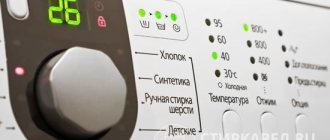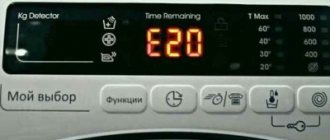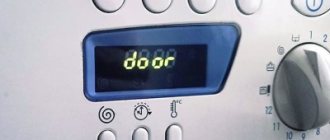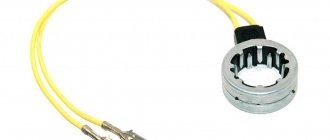Most washing machines from Indesit have a lock indicator, which is a separate LED on the dashboard. Using this light, you can monitor the condition of the machine and promptly detect any malfunction. If the lock on the Indesit washing machine is blinking, but the equipment itself does not start or works intermittently, urgent diagnostics are needed. Such a “diagnosis” can result in serious consequences, so it is better to react correctly to the blinking light bulb.
Button that starts processes
After successfully diagnosing the power cord and FPS, we move on to the dashboard. The fact is that on Atlant washing machines, when one or more keys stick, a failure occurs, after which the entire system is de-energized. While modern washing machines can withstand such a shock and display a corresponding error on the display, older models cannot cope with the load and simply “go silent.”
To understand whether the problem is caused by a stuck key, you need to perform several steps:
- open the detergent tray and, pulling it towards you, remove it from the housing;
- Unscrew all the screws holding the dashboard;
- carefully disconnect the panel from the machine (you don’t need to completely unhook the board - you just need to gain access to the “internals”);
- switch the multimeter to resistance mode;
- Apply the probes to the button contacts and measure the resistance.
Practice shows that sticking of the “Start” button more often leads to an emergency shutdown of the machine. If it works, then there is a problem with the other keys being used. We check everything sequentially. If sticking keys has nothing to do with it, then there is a high probability that the problem is in the electronic module. Here it is better to turn to specialists.
Share your opinion - leave a comment
If there is no power
There are a number of reasons why the equipment does not work after switching on. If the display or indicators on the Indesit washing machine do not light up, this indicates a lack of power. This happens if:
- There is no electricity.
- The machine or RCD tripped.
- The socket is faulty.
- The power cord is broken.
- The power button is broken.
- FPS malfunction.
- The control unit is broken.
Electricity problems
The first thing you should check if the automatic washing machine shows no signs of life is the presence of voltage. You can turn on the lights and other mains-powered devices to make sure there is electricity.
If there is a separate line to the Indesit washing machine, you should make sure that the machine is not knocked out. This could happen if moisture got into the outlet or there was a short circuit. You need to check it and turn it on if it is knocked out. If it turns off again, you need to look for the cause of the short circuit.
If the equipment is connected through an RCD, it could be triggered if electricity leaks to the body. Sometimes the protective confinement device fails if it is of poor quality or the wiring is poorly done.
Another reason why the Indesit washing machine does not receive power is a malfunction of the socket or extension cord through which the product is connected to the network. You can connect another electrical device to them or use an indicator screwdriver, a multimeter or a light bulb with wires attached.
If everything is in order with the electricity, you should proceed to diagnosing the Indesit washing machine. To do this, you will need to disconnect it from the network.
The power cord is faulty
First you need to inspect the power wire. It may have been broken due to constant bending or damaged by pets. If no external defects are found, you need to “ring” it with a multimeter. If the wire is truly faulty, it should be replaced or, if a break is detected, twisted. But it is not recommended to resort to the last method.
Power button broken
After the power cord, you need to check the power button. This can be done with a multimeter operating in buzzer mode. After this, you need to ring the button. If it is turned on and working properly, the multimeter will beep, but if it is in the off position, the device is silent.
FPS is faulty
The next part that needs to be checked after the power button is the noise filter (FPS). Its purpose is to eliminate electromagnetic waves coming from the Indesit washing machine that interfere with the stable operation of a TV, radio or other equipment located nearby. If it is damaged, the current no longer flows and the washing machine does not turn on. The filter also protects the control unit from burnout after a power surge. To troubleshoot the problem you must:
- Disconnect the machine from the sewer and water supply.
- Unscrew the fasteners and remove the back cover.
- The mains capacitor is located near the left side wall; you need to remove it and disconnect its wire from the mount. If the filter is burnt out, it can be easily determined visually.
- Now you need to disconnect the contacts of the power cord, disconnect the FPS, set the multimeter to ring and check the wire. If it is defective, it must be replaced.
- Next you need to call the FPS. If it rings, you need to check the capacitor with a multimeter in resistance test mode. If it is faulty, the display will show a zero or a one. In this case, the part needs to be replaced. You need to purchase a new one in accordance with the device model; it is sold both separately and with a power cord.
Varistor is faulty
The next thing you need to check is the varistor. This is the name of a semiconductor resistor that is soldered into the system board and protects it from surges. During power surges, they often burn out, after which the Indesit washing machine does not turn on and the indicators do not light up. To check it, you need:
- Pull out the detergent cuvette, there are two screws under it, they need to be unscrewed.
- Remove the top cover, unscrew the fasteners, and remove the control panel.
- Disconnect the central board.
- Find varistors. If they are burned, as a rule, they are easy to detect - they are blackened or burnt with traces. If external damage is not visible, you need to check it with a multimeter in resistance mode.
- The non-working varistor needs to be unsoldered, then purchased a similar one from a service center or store and soldered in its original place.
If, after checking and replacing the varistor, the washing machine still does not turn on, you should contact a specialist for further repair work. It is not recommended to try to repair the control board yourself, because you can completely damage it.
If the indicators light up, burn randomly or go out
The Indesit washing machine may start, but not work, not only because the lock does not turn on, but also due to other malfunctions, for example, a system failure. In this case, the lamps blink randomly or light up and immediately go out. You need to disconnect the machine from the network and wait a few minutes; if this does not help, open the instruction manual and look in it for information about performing a system reset.
In some cases, erratic blinking of light bulbs may occur due to wiring problems. It burns out or the connectors become loose due to constant vibration. It is necessary to carefully inspect the wires and then test them with a multimeter. Damaged elements are replaced with new ones. Usually you can talk about a wiring fault if the machine blinks and does not turn on.
If the lights blink in a certain sequence, this means that the machine has completed a self-diagnosis program and is reporting some kind of breakdown. To decipher the code, you need to open the user manual, it contains detailed information.
AE
The error indicates an automatic shutdown of the equipment as a result of a failure in the water supply system, or a malfunction of the main board. The first thing to do is to reboot the equipment, completely disconnecting it from power for 10-15 minutes.
Then check the water drain pan. This problem is especially relevant for washing machines that have Aquastop leak protection installed on board.
It is necessary to check all hoses for physical damage, and also tighten the clamps if they are loose. Then get rid of the water in the pan. If the leak remains, then after the first wash the container will fill with liquid.
How to recognize a breakdown in equipment?
Complaints that the SMA does not turn on have a variety of manifestations that can accompany such a problem:
- when you press the “Start” button, the unit does not give any signals;
- after switching on, only one indicator blinks, and nothing else works;
- after an unsuccessful startup attempt, all light indicators light up and flash at once.
Sometimes the machine clicks and crackles, but the motor does not work, which means the drum does not rotate, water does not fill, and the SMA does not begin to erase. If you have made sure that current flows freely into the washing machine, then you need to take a number of measurements. They will allow you to identify the cause of failure of internal elements.
Failure to start washing is often due to a broken “On” button. A similar problem is common in the latest SMA models, in which current is supplied from the power cord directly to the button. In order to diagnose the serviceability of an element, you need to perform a number of simple steps:
- disconnect equipment from the power supply;
- raise the top panel of the unit;
- disconnect the control unit on which the button is located;
- disconnect the connection section of the wiring and buttons;
- connect a multimeter and calculate the supply of electric current in the on mode.
If the button is working properly, the device produces a corresponding sound.
If the equipment turns on and the light indicators on it light up, but the washing does not start, it is likely that the hatch is blocked. Most often, the SMA blocks the door at the start of the program
If this does not happen, then you should pay close attention to this node. To do this, you need to disassemble the front part of the SMA housing and then use a special tester to measure the voltage supply. If monitoring confirms that electrical current is flowing, but the device does not work, you will need to replace it
If monitoring confirms that electrical current is flowing, but the device does not work, you will need to replace it.
If the mechanism indicates a lack of voltage, then perhaps the problem is related to the failure of the command device or the working electronic unit.
Any unit has a special element responsible for suppressing electromagnetic radiation during operation - it is called an interference filter. This part protects the SMA from electrical waves that can render it inoperative. If the filter breaks, the machine will not be able to turn on - the indicators in this case do not light up.
Many SMAs are designed in such a way that the internal wires are in close contact, so if the equipment vibrates strongly, they can tear and fall out of the socket. In order to determine the area of damage, you should completely disassemble the MCA and use special testers.
Another common reason for no washing is a faulty electronic board. Its functionality is usually checked only after the accuracy of the connection of all operating microcircuits has been established, and the absence of damage to the wiring, plug, and also the mechanism responsible for locking the hatch door.
If the washing machine stops starting after a power surge, then the first thing you need to do is check the power supply filter - it prevents the electronic board from burning out and very often suffers itself if there is a fault in the electrical network.
This check is quite simple to carry out. To do this, you need to unscrew all the mounting bolts from the back panel and remove it, then find the surge protector (usually it is located on the side), and then carefully inspect all the wires and contacts leading to it. If you notice burnt out elements or a swollen filter, they will have to be replaced. If the problem cannot be detected, you need to test the contacts with a multimeter.
If the check does not produce any results and the network connection is working, then you should proceed to diagnostics of the command device. You will have to disassemble this element into the smallest parts and carefully inspect them. To do this you need to perform several steps:
- remove the command device and disassemble it;
- by pressing the latches located on the sides, you need to open the cover and remove the board;
- The board should be carefully inspected for burning, and then use a multimeter to measure the resistance at the contacts.
After this, all that remains is to make sure that there is no debris or foreign particles, visually determine the integrity of the working elements, if necessary, treat them with alcohol and reassemble them in the reverse order.
If there is no power
There are a number of reasons why the equipment does not work after switching on. If the display or indicators on the Indesit washing machine do not light up, this indicates a lack of power. This happens if:
- There is no electricity.
- The machine or RCD tripped.
- The socket is faulty.
- The power cord is broken.
- The power button is broken.
- FPS malfunction.
- The control unit is broken.
Electricity problems
The first thing you should check if the automatic washing machine shows no signs of life is the presence of voltage. You can turn on the lights and other mains-powered devices to make sure there is electricity.
If there is a separate line to the Indesit washing machine, you should make sure that the machine is not knocked out. This could happen if moisture got into the outlet or there was a short circuit. You need to check it and turn it on if it is knocked out. If it turns off again, you need to look for the cause of the short circuit.
If the equipment is connected through an RCD, it could be triggered if electricity leaks to the body. Sometimes the protective confinement device fails if it is of poor quality or the wiring is poorly done.
Another reason why the Indesit washing machine does not receive power is a malfunction of the socket or extension cord through which the product is connected to the network. You can connect another electrical device to them or use an indicator screwdriver, a multimeter or a light bulb with wires attached.
If everything is in order with the electricity, you should proceed to diagnosing the Indesit washing machine. To do this, you will need to disconnect it from the network.
The power cord is faulty
First you need to inspect the power wire. It may have been broken due to constant bending or damaged by pets. If no external defects are found, you need to “ring” it with a multimeter. If the wire is truly faulty, it should be replaced or, if a break is detected, twisted. But it is not recommended to resort to the last method.
Power button broken
After the power cord, you need to check the power button. This can be done with a multimeter operating in buzzer mode. After this, you need to ring the button. If it is turned on and working properly, the multimeter will beep, but if it is in the off position, the device is silent.
FPS is faulty
The next part that needs to be checked after the power button is the noise filter (FPS). Its purpose is to eliminate electromagnetic waves coming from the Indesit washing machine that interfere with the stable operation of a TV, radio or other equipment located nearby. If it is damaged, the current no longer flows and the washing machine does not turn on. The filter also protects the control unit from burnout after a power surge. To troubleshoot the problem you must:
- Disconnect the machine from the sewer and water supply.
- Unscrew the fasteners and remove the back cover.
- The mains capacitor is located near the left side wall; you need to remove it and disconnect its wire from the mount. If the filter is burnt out, it can be easily determined visually.
- Now you need to disconnect the contacts of the power cord, disconnect the FPS, set the multimeter to ring and check the wire. If it is defective, it must be replaced.
- Next you need to call the FPS. If it rings, you need to check the capacitor with a multimeter in resistance test mode. If it is faulty, the display will show a zero or a one. In this case, the part needs to be replaced. You need to purchase a new one in accordance with the device model; it is sold both separately and with a power cord.
Varistor is faulty
The next thing you need to check is the varistor. This is the name of a semiconductor resistor that is soldered into the system board and protects it from surges. During power surges, they often burn out, after which the Indesit washing machine does not turn on and the indicators do not light up. To check it, you need:
- Pull out the detergent cuvette, there are two screws under it, they need to be unscrewed.
- Remove the top cover, unscrew the fasteners, and remove the control panel.
- Disconnect the central board.
- Find varistors. If they are burned, as a rule, they are easy to detect - they are blackened or burnt with traces. If external damage is not visible, you need to check it with a multimeter in resistance mode.
- The non-working varistor needs to be unsoldered, then purchased a similar one from a service center or store and soldered in its original place.
If, after checking and replacing the varistor, the washing machine still does not turn on, you should contact a specialist for further repair work. It is not recommended to try to repair the control board yourself, because you can completely damage it.
How to fix the error yourself
Before proceeding with active steps, read the instructions supplied with the unit. It must contain a troubleshooting section that lists symptoms and/or error codes, as well as possible solutions. If the actions described in the instructions turned out to be useless or the instructions are completely lost, read our recommendations - perhaps they will help you understand how to fix the problem that has arisen in your washing machine.
There are several standard situations when the washing machine does not turn on, and several or all indicators on its body light up or flash alternately. Let's look at the most common of them.
| Cause of the problem | Remedies |
| There is no water flowing into the washing machine | Check:
|
| Control module failure | Try turning off the washing machine from the network and turn it on again after 10 - 20 minutes. |
| Child lock activated | Disable this option. Information on how to do this is indicated in the instructions for the washing machine. |
| The washing machine does not drain water | Make sure the drain hose is not clogged or kinked. If the washing machine drain is drained into the sink siphon, check for blockages and the connection between the drain hose and the sewer. |
| Damage to the power cord or plug | Check the integrity of the cable; if it turns out that the power cord is damaged, it should be replaced - this can be done independently or by contacting a specialist. |
| The washing machine is overloaded or underloaded | Arrange the laundry in the drum more evenly; if this does not help, you should reduce or, conversely, increase the machine load |
| Incorrect installation of the unit | You may have placed the drain hose below the level of the machine's tank, which is causing the washing machine to constantly fill and drain water, and then give an error message. Connect the machine to the sewer correctly or use the service of a washing machine installation specialist. |
If the buttons on the washing machine continue to blink and you cannot fix the problem yourself, most likely there is a breakdown. In this case, you cannot do without a professional washing machine repair technician.
Meaning of indicators and codes
A working machine systematically carries out a set of commands, notifying about the current stage with indicators, alternating the usual hum with small stops.
A failure immediately makes itself known by beeping, an uncharacteristic sound, blinking, or the absence of any action at all. And most importantly, the smart mechanism immediately gives the owner a code for the malfunction that has occurred, which can be used to quickly make repairs.
The codes required for diagnostics for errors that have occurred according to the design of the Indesit washing machine are displayed:
- on the general display – when the model is equipped with a panel screen;
- using combined flashing of the command lights - on models without a display.
It is most convenient if the so-called washing machine has a display: the fault number immediately lights up on it. It is enough to notice it and proceed to verify the values, and then proceed to eliminate it.
Advanced Indesit models always have a digital display on the panel. It will definitely display the breakdown number, even if the screen previously showed another function being performed.
If we are talking about models without a separate display, you need to stay at the next section and carefully study the LED blinking combinations that reveal the current error code.
In operating condition, the indicators on the machine panel light up in accordance with the command being executed. However, as a rule, they do not flicker with a high frequency, but blink smoothly and/or shine constantly.
Indicators that light up at random, at the same time as others and begin to flicker quickly, indicate a breakdown.
The notification occurs depending on the model range:
- Electronic-mechanical line Indesit IWDC, IWSB-IWSC, IWUB and its analogues - the failure code is recognized by the lighting LEDs of the working phases on the right (door block, rinsing, draining, spinning, etc.), the signal is also accompanied by the simultaneous flickering of the upper additional indicators and network indicator.
- The model range marked WIDL, WIL, WISL–WIUL, WITP - on the contrary, the type of failure is indicated by the lighting of the top line of additional function lamps along with the last diode of the left column (most often this is “Spin”), and at the same time the door block icon quickly blinks.
- Models of the WIU, WIUN, WISN series and their analogues - all lights, including the lock icon, are involved in indicating the error.
- The oldest prototypes of Indesit W, WI, WS, WT with only two light buttons - block and network - blink continuously and quickly exactly as many times as the number in the error number means.
All that remains is to look carefully and determine which indicator lights are signaling, check the combinations with the list of fault codes and choose the right path for repair.
The function display panel of the latest Indesit models is located vertically on the right, and not horizontally at the top, like the others, and the signals need to be read from it
We will try to figure out how to unravel the meaning of the codes and correct the situation by performing feasible repairs.
The washing machine blinks all the lights, but does not turn on
Lack of response to user commands, and the inclusion of all indicators and buttons indicates the presence of a technical malfunction - the control board is broken. This component fails due to power surges. Short circuits become a catalyst for capacitor burnout. If you know how to use a soldering iron, you can change them yourself.
Sometimes only the lock indicator lights up, but the machine still does not turn on. Make sure parental controls are deactivated. You may have turned on the child lock, so the buttons do not work. If only certain lights come on, for example, the service button indicator, then you need to disassemble the washing machine to check the serviceability of the following components:
— the electric heater (heater) burned out;
— there were problems with the pump;
— failure of the electronic motor;
— failure of the sensor transmitting commands.
It is necessary to identify the damaged node and restore its functionality. Modern washing machines are sensitive to overload because they are equipped with a special sensor that weighs the laundry before starting washing. To restart the cycle, open the door and arrange the clothes evenly or remove some of the laundry.
Description of the situation
Often, the user is faced with a situation in which the indicator light blinks, but the washing process does not start. Or the work process has started, the rinsing stage begins, but the unit randomly changes the washing process and selects an inappropriate temperature mode. However, if the device is disconnected from the power supply and then turned back on, the situation does not change.
Starting the washing machine
Note that this situation often occurs when operating washing machines of the following brands:
But one should not assume that this is due to the poor quality of these machines. It’s just that in units of other brands this type of breakdown is displayed on the display using a letter code.
Problems with the washing machine lock indicator
Features of Indesit witl repair
For free
Call and diagnosis
Spare parts
Own warehouse
10% discount
For beneficiaries We continue the series of articles on repairing washing machines with our own hands. All Indesit witl 106, witl 86, witl 1067, witl 867 models are similar to each other and the repair problems are the same.
Washing machines can be assembled on an ARCADIA or EVO-II electronic board
This depends on your CMA product number.
Deciphering the error code by flashing indicators:
By adding the numbers corresponding to the blinking LEDs, you will receive an error code.
As an example of error F10, we add the sum 8+2=10 (F10).
Faults by error code (EVO-II board):
We have already published in a previous article how to troubleshoot a fault on the EVO-II board of WISL models by error code. They are similar to each other.
Faults by error code (ARCADIA board):
This board is the newest of all, it replaced the EVO-II. Installed since 2007. Schematic connection of the Arcadia control board with end devices
1. Anti-interference filter (power capacitor) 2. Heating element 3. Pump (pump) 4. Door locking device 5. Tachogenerator 6. Motor stator 7. Electric motor rotor 8. Main wash water intake solenoid valve 9. Pre-wash solenoid valve 10. NTC (temperature) sensor 13. Water level switch (pressostat) 14. Linear water level switch
When the machine does not display an error code:
— When plugged in, the door immediately locks (a click is heard) and the hatch lock indicator light comes on. Suspicion of a breakdown of the motor triac, burnout of the resistance, or short circuit of the motor.
It is necessary to remove the top cover by unscrewing the screws:
Visually inspect the board by unscrewing the fasteners:
Next, we use a tester to call the engine block (6 wires, 2 of which are red - tacho, and 4 black are divided in pairs: rotor and stator):
— Frequent malfunctions are associated with the engine. It is a collector type.
For example, after pressing the start button, the hatch lock is activated and “silence” occurs. In many cases, brush wear can be determined by external inspection or by the intensity of sparking on the engine commutator: both under load (there is laundry in the machine tank) and without it - in this case, abundant sparks occur (not along the entire perimeter of the commutator).
If the brushes wear out significantly, there is a loss of engine power - for example, if the drum of the washing machine does not “turn” with the laundry loaded into it.
Engine control circuit via tachogenerator (ARCADIA module):
— It takes an infinitely long time to wash, constantly filling and draining water.
It is necessary to properly organize the drainage system. The tip of the hose should be at a height of 60 to 100 cm.
In addition, a break in the stream must be ensured when draining to avoid water being sucked back into the SM.
-All indicators flash, except for the pre-rinse, main and rinse.
The hero of the occasion is the control unit (module), namely the switching power supply in it. An incorrect signal (voltage) is sent to the board and the lights blink.
Where is this module located:
With front loading, it is located under the tank on the rear side. In the vertical racks under the top control cover.
What to look for in the power supply is the swollen capacitors C17, C16, C20. We select new capacitors, maybe 1000 uF. We take a soldering iron and change
We select new capacitors, maybe 1000 uF. We take a soldering iron and change them.
Exploded top view:
001 - control knob 002 - white on/off/reset buttons 003 - white control panel 004 - bitron switch 005 - function keys 007 - display 008 - lid handle 010 - dispenser release lever 011 - dispenser hook spring 012 - dispenser release button 016 - cover support 018 - partition with shock absorber 021 - door locking device 022 - white dispenser 023 - siphon cover 026 - control panel wiring 027 - 8-pos. potentiometer
Major breakdowns
Let us repeat once again - in such a technically complex Indesit device there are things that can break and it is not always possible to cope with breakdowns on your own. But again, repairs do not always end in the workshop. Perhaps such strange behavior of the device as:
- the device began to work unstably;
- the detector lights on the control panel light up in a chaotic manner;
- if the display shows errors whose names begin with F;
- there are traces of leaks;
- there is a strong smell of burning wiring or smoke appears.
If this is noticed, then it’s time to pay serious attention to your home assistant and call a specialist for an examination. And the probable causes of breakdowns can be seen from the table
| Malfunction | Probable Cause | Eliminating the causes of breakdowns |
| the device does not turn on, there is no response to entered commands on the control panel, the indicators blink |
|
|
| the washing process begins to drag on in time, the modes themselves begin to respond to commands incorrectly or there is a need for manual control of the washing modes |
|
|
| loud noise and clatter from the washing machine |
|
|
| the drum stopped rotating |
| check the integrity of the power circuit to the drum lock electromagnet. |
| problems with filling and draining water |
|
|
| leaks |
|
|
| The washing machine does not spin or does not respond to commands at all |
|
|
| there was a smell of burnt wiring with the appearance of smoke |
|
|
Ten often causes problems with the washing machine
Do-it-yourself repairs
Modern Indesit devices have a display to monitor the operating status. If any malfunction occurs, an error code is displayed on the display. In the instructions supplied with the washing machine, you can find a decoding of the codes. Having determined the cause of the breakdown, it is easier to fix the problem on your own or invite a specialist from the workshop and calculate the amount of repair work.
LCD display of washing machine
But there are also devices that do not have an LCD display and an error removal program. The owner of the washing machine will then have to proceed with the inspection and try to fix the problem himself. If the control panel does not light up with all the colors of the signal lights, there is no smoke or burning smell, and there are no leaks, this means that there are no serious breakdowns and you can try to fix the problem on your own.
Here are some simple problems and ways to solve them:
- When you press the power button, nothing happens - check whether the plug is inserted or whether the contact is tight enough. It is also possible that the mechanism for protecting the electrical network from a short circuit has tripped. This can happen from strong power surges;
- water does not flow - restart the machine by pressing the start and stop button. Check that the door is closed tightly and that there is enough water pressure. Is the water supply tap turned off?
- if nothing happens after pressing the start button, repeat the same steps. Check whether the water supply hose is damaged or whether the delayed washing mode is running;
- Check the installation height of the drain hose if there is constant draining and intake of water. Bring the high point of the hose to a height of 70 centimeters;
- extraneous loud sounds can be caused by solid objects that have fallen out of pockets getting into the washing machine drum - coins, pens, and so on;
- Excessive foaming makes work difficult and is caused by incorrect selection of washing powder. Washing powder must be specifically for automatic machines;
Excessive foaming is also a cause for concern
- the “spin” function does not work or the water does not come out after the “rinse” cycle - the drain hose may be kinked or clogged. The mode may be incorrectly selected. With the “light ironing” or “no spin” modes, this effect may occur. Restart the washing process by pressing the "Start/Pause" button. To find out other reasons why, we recommend studying this material;
- If there is strong vibration or during washing, or during the spinning process of the Indesit machine, check the uniform distribution of the laundry. If the device has been moved to another location, check whether there is any distortion in the installation;
- All the indicators came on at once for no apparent reason. A complete disconnection from the power supply will help. When turned on again, their operation may be restored.
Washing machine disassembly diagram
Rare reasons for all lights to blink
The visual information system sometimes works for other reasons. Sometimes confusion arises, so first you need to accurately determine the malfunction:
- involuntary drainage of water;
- burnout of the heating element for water and drying;
- motor failure;
- breakdown of the drain pump, etc.
If the washing machine is not working, the indicators will flash accordingly.
The heating element becomes coated with scale over time, causing increased wear. The motor can break down due to worn brushes or entangled hair and fur. The control device fails much less often; usually the cause is burnt contacts.
Check error codes according to Indesit instructions. Accurate diagnostics make it easy to repair the washing machine without major financial investments.
Interference filter (FPS): meaning and performance check
The control module, electric motor and other parts create radio frequency waves when the washing machine is running, which can harm other household appliances located near the machine. To protect electrical devices, the machine is equipped with an interference filter. If it malfunctions, it will create an obstacle to the passage of electric current. This will be the reason why the automatic machine does not start the washing process. To check the functionality of this part, you need to diagnose the wires at the input and output, as well as the device itself using a tester. If the FPS does not work, you need to order a new filter from the service center or make a request for its replacement.
Preparing for fault diagnosis
If such a situation occurs with an Indesit machine, the first thing we do is disconnect it from the network, and do not open the hatch. First, use the button on the panel, then disconnect the cord from the outlet. Cover the floor around with towels and rags, place a container underneath the drain filter, like a scoop or container, and only then open it. The plug opens counterclockwise; if it is screwed tightly, use pliers. After all the water has drained, you can clean the drum from the laundry.
After all the operations, it is worth understanding at what point the drum stopped rotating. The chronology of work will help to establish the exact reason for its stop. If a failure occurs during the spin cycle, and the laundry is damp but not soapy, then you need to check the selected washing mode. If the delicate wash is turned on or the “no spin” function is active, then this small misunderstanding can be easily corrected. The water does not drain due to a blockage in the drain system, and therefore spinning does not occur. Also, stopping the drum’s operation may be due to an overload of things, due to which an imbalance has occurred. Problems with the pressure switch or control module lead to failures during the washing process. Expressed in burnt out wiring or errors in the control module.
Engine
If the washing machine motor is faulty, water may get into the drum. It is necessary to check the following motor elements:
- wiring;
- slats;
- brushes.
When there is standing water in the drum, it is first drained through a surge filter and the equipment is disconnected from the electrical network. Certain steps must be taken to remove the engine:
- The screws are unscrewed from the panel at the back.
- The panel is removed (you can see the motor under the tank).
- The wiring is disconnected.
- The fasteners are unscrewed and the engine is pulled out.
If the brushes are worn out, they are replaced. The lamellas are also changed or turned on a lathe. The wiring is checked and replaced if necessary.











